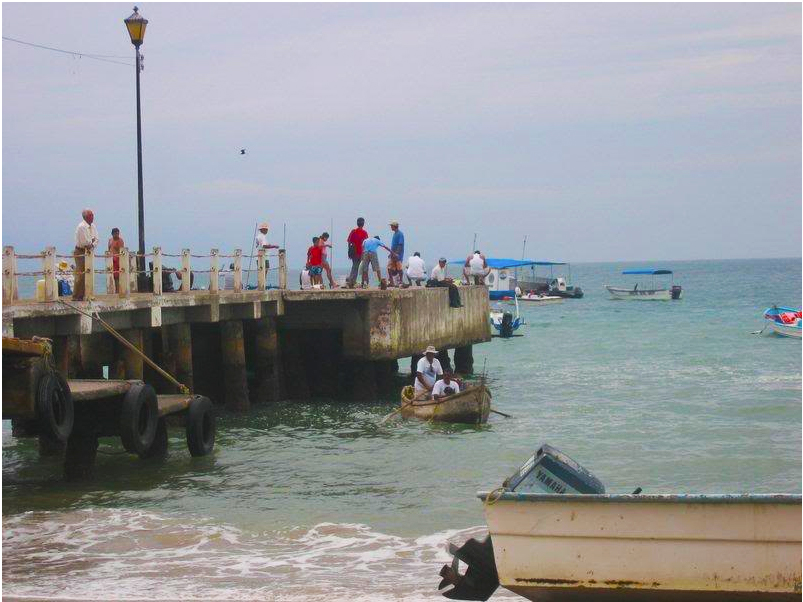With the sun rising up over the Sierra Madre, we drove into Puerto Vallarta to the Los Muertos Pier where the water taxis depart for Yelapa. I guess I don’t have to tell you what Los Muertos means. Calling it a pier is a bit of a stretch. Particularly at the moment when it is nothing more than a few ribs of concrete that are being jackhammered apart during reconstruction. As you walk towards the pier you are accosted by at least half a dozen locals wanting to sell you a ticket to Yelapa even before they know that’s where you’re going. They all assure you that it is not part of any time-share scheme, which is a bit confusing because I don’t know of any time-shares in Yelapa. Anyway, we waded through the salesman to the little stand next to a palapa restaurant and bought our tickets. A one-way ticket is 120 pesos and a round-trip ticket is 250. It could drive you nuts if you tried to figure out why they charge more for a round-trip ticket than for two one-way tickets. This is just the way it is in Mexico.
The water-taxi was nothing more than a large panga named Carey which we could see bobbing in the surf maybe ten yards beyond the end of the decrepit pier. The man selling the tickets told us that the boat would leave at 10 and then asked us what time we wanted to return. We told him 3 and he circled that time on the return ticket for which we’d paid an extra 10 pesos each. Paige wanted to walk up the street and get a jugo of fresh beet and orange juice but the boat was scheduled to leave in a few minutes so we just stood around watching three bare-chested young men hammer away at the concrete pier. Fifteen minutes went by and then half an hour and still we were waiting for the panga to come pick us up but it continued to bob in the surf while its pilot snoozed on the seat cushions. Finally around 10:30 it was brought up to the pier and there was much shouting of instructions and a certain chaos as three men tried to both keep the boat from smashing into the concrete pier and get passengers aboard the boat as it rose and fell several feet with the waves. There was one old woman carrying several large parcels who simply couldn’t navigate the distance between the pier and the bobbing boat so that eventually some other men were called forth and two men lifted her up in their arms and handed her down to two other men on the panga as if she were a large child.
Even after everyone had managed one way or the other to board the water taxi nothing much happened. We pushed off from the pier and stayed just off-shore, wretchedly lurching up and down in the unusually large swell. I asked one of the men on the boat, who was wearing a red scarf and a white cap, as if he’d just come from the running of the bulls in Pamplona, what we were waiting for and he shrugged and said, “Don’t worry. We are leaving soon.” After a few minutes we motored back to the pier and went through the lurching up and down against the concrete process all over again as three more passengers were loaded. Finally, we pushed off.
We had a two-man crew: a very young man bundled up in a fleece jacket buttoned up to the chin and the older man in white cap and red scarf. The young man started out as the captain but then got sick and the older man took over. I was sitting next to him and asked him what the problem was and he said the boy was sick. Probably with the flu. We slowly made our way down along the coast to Los Arcos, a Mexican marine park near Mismaloya where John Huston filmed Night of the Iguana, the 1964 movie that made Puerto Vallarta famous. The panga stopped and Ruso, the man with the white cap and red scarf, got a bag out from under his seat and started throwing handfuls of stale bread into the green waters. At first nothing happened and then there was a woosh! and a whole school of angel fish, moving as one, came up to the surface for the bread. Ruso tossed more and more bread into the water, luring them closer to the boat until you could reach out with your hand and touch the top of the fish. Nothing could be worse for these fish than eating stale bread, of course, but telling Ruso that would be pointless. This is the way they did it; they took the tourists to Los Arcos and they fed the fish stale bread. Meanwhile, the young man who had started out as the pilot on our panga was doing his own sort of chumming from the back end of the boat, wretching into the water.
The morning was cool and the wind was up and everyone on the boat either pulled on jackets or sweaters or wrapped beach towels around their bodies. The old woman had a blue wool blanket and wrapped it over her head and shoulders like the Virgin of Guadalupe. For half an hour we rode like this, bouncing over the waves, passing other pangas headed the other direction towards Puerto Vallarta, until the boat slowed and we turned into a misty cove with a curving beach at the end and brightly-colored buildings leaning out of the jungle that rose up from the water and into the hills. We’d reached Yelapa.


Recent Comments